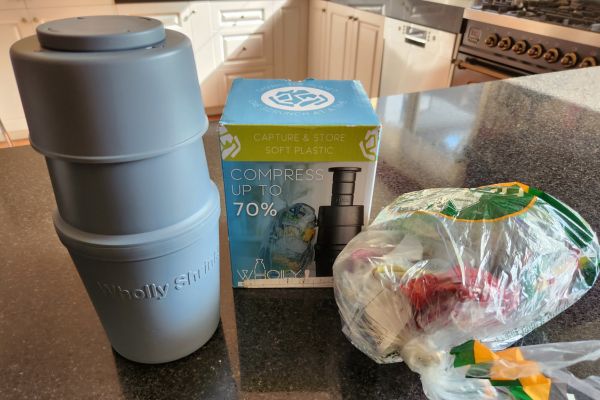Not only is it Earth Day tomorrow, but it’s also World Book Day, at least for part of the world (The UK and Ireland celebrated it back in March, but who said you couldn’t celebrate two world book days!). In honor of these two significant dates, I thought I’d share some of the books I’ve read in recent years that have had a lasting impact on me.
If you are interested in grabbing a copy of any of these books, remember to reduce your impact by:
- Checking if your local library has a copy
- Buy second hand copy if you can find one
- Buy a digital version to read
- Sharing the books with friends and family when you are done
- Selling it second-hand to keep the book in use as long as possible.
Happy reading and have a great Earth Day!
Plastic: A toxic love story
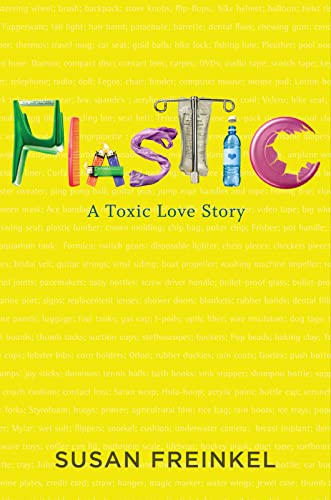
“Plastic: A Toxic Love Story” by Susan Freinkel is a well-researched and eye-opening book that delves into the world of plastic and its impact on our lives and the environment. Freinkel’s writing style is engaging and accessible, making it easy for readers to follow along as she unpacks the complicated and often overlooked issue of plastic pollution.
Through extensive research and interviews with experts, Freinkel takes readers on a journey through the history of plastic, from its invention in the early 20th century to its ubiquitous presence in our modern-day lives. She explores the many different ways that plastic is used, from food packaging to medical devices, and the impact that it has on our health and the environment.
What I love about the book is that she focuses on several common items like plastic bags, plastic chairs, and disposable lighters. Items we can all easily relate to from our everyday lives. This brings into perspective how deep our relationship with plastic is.
One of the strengths of the book is Freinkel’s ability to convey complex scientific concepts in a way that is easy to understand. She breaks down the chemical makeup of plastic and explains how it can leach harmful toxins into our food and water. She also explores the ways in which plastic waste is affecting our oceans and wildlife, and the potential long-term consequences of our dependence on this material.
While the book certainly highlights the negative impact of plastic, Freinkel also acknowledges the many benefits that plastic has brought to our lives. She notes that it has revolutionized medicine, transportation, and communication, making many products more affordable and accessible. However, she argues that we must find a way to balance these benefits with the need to reduce our plastic consumption and mitigate its environmental impact.
Overall, “Plastic: A Toxic Love Story” is a well-written and informative book that offers a balanced perspective on the issue of plastic pollution.
The Day the World Stops Shopping
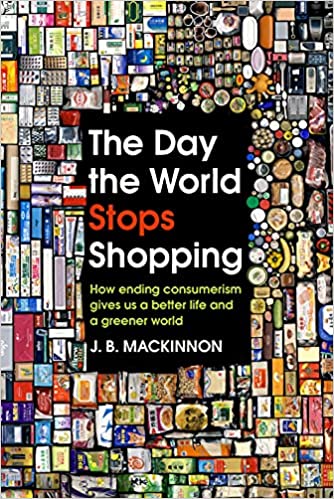
“The Day the World Stops Shopping” is a timely and thought-provoking book that challenges readers to re-evaluate our collective relationship with consumption and the impact it has on our planet. Written by J.B. MacKinnon, the author of “The 100-Mile Diet,” this book takes a similarly radical approach to the global issue of overconsumption.
MacKinnon argues that our current way of life is unsustainable and that we need to take urgent action to change our course. He envisions a future where we consume less, but live more fulfilled lives. He also suggests that this future is not only possible but desirable.
What I like about this book is that not only does the book address the issue of overconsumption, but it also provides practical answers. MacKinnon suggests that we need to create an economy that is not based on growth and that prioritizes well-being over profit. He also suggests that we need to rethink our relationship with work, leisure, and the natural world.
Overall, “The Day the World Stops Shopping” is a compelling and thought-provoking book that offers a fresh perspective on the global issue of overconsumption.
Secondhand: Travels in the new global garbage sale

“Second Hand” by Adam Minter is a fascinating and insightful exploration of the secondhand economy and its role in our globalized world. Minter, a journalist and longtime observer of the recycling industry, takes readers on a journey around the world to explore how secondhand goods are bought, sold, and repurposed.
Minter argues that the secondhand economy is essential to our economic system, providing opportunities for people to buy and sell goods that might otherwise go to waste. He shows how secondhand markets have evolved over time, from local flea markets to global online platforms such as eBay and Alibaba.
One of the strengths of the book is Minter’s ability to weave together personal anecdotes, historical context, and data-driven analysis to paint a vivid picture of the secondhand economy. He highlights the many benefits of buying and selling secondhand goods, such as reducing waste and saving money, while acknowledging the challenges and inequalities within the industry.
Another strength of the book is Minter’s global perspective on the topic. He travels to countries such as China, India, and Ghana to explore how secondhand markets operate in different cultural and economic contexts. This makes for a fascinating read and highlights the interconnectedness of our global economy.
Overall, “Second Hand” is a well-researched and engaging book offering a unique global economy perspective on reuse through secondhand markets.
The Story of Stuff: The Impact of Overconsumption on the Planet, Our Communities, and Our Health

“The Story of Stuff” is a powerful and thought-provoking book that delves into the consumerist culture that has become so ingrained in our society. Written by Annie Leonard, an environmental activist, and educator, this book challenges readers to rethink their relationship with “stuff” and the impact it has on our planet.
Leonard presents a compelling argument that our current economic system is built on the assumption that we need to constantly consume more and more stuff, regardless of the environmental and social costs. She takes readers on a journey through the life cycle of our products, from extraction to disposal, and exposes the hidden environmental and social costs that are often ignored in the pursuit of profit.
Leonard uses a combination of personal anecdotes, scientific research, and humorous illustrations to explain how our consumerist culture has come to dominate our lives and why we need to change course.
She also offers practical solutions to address the problems of overconsumption and waste. Encouraging readers to take action at both the individual and systemic level, such as reducing their personal consumption, supporting sustainable companies, and advocating for policy changes.
Overall, “The Story of Stuff” is a must-read for anyone who is interested in sustainability, environmentalism, or social justice.
Peak Plastic: The Rise or Fall of our Synthetic World

“Peak Plastic: The Rise or Fall of Our Synthetic World” by Jack Buffington is a comprehensive and engaging book that explores the many ways plastic has become an integral part of our lives and the challenges we face managing its impact on the environment.
Buffington takes a global and historical perspective on the issue, tracing the rise of plastic from its early development in the early 20th century to its ubiquitous presence in our daily lives. He also delves into the complex political and economic forces that have shaped the plastic industry and the challenges we face in reducing its impact on the environment.
Buffington’s ability to communicate complicated scientific and technical topics in an understandable manner is one of the book’s strengths. He explains the chemical composition of plastic, its resilience and longevity in the environment, and the numerous ways it may impact species and ecosystems.
Another strength of the book is Buffington’s nuanced approach to the issue of plastic pollution. He acknowledges the many benefits that plastic has brought to our lives, such as improving food safety and medical care, but also highlights the need to address the negative impacts of plastic on our health and the environment.
Overall, “Peak Plastic” is a well-researched and thought-provoking book that offers a balanced perspective on the complex issue of plastic pollution.
Fashionopolis: The Price of fast fashion & the future of clothes
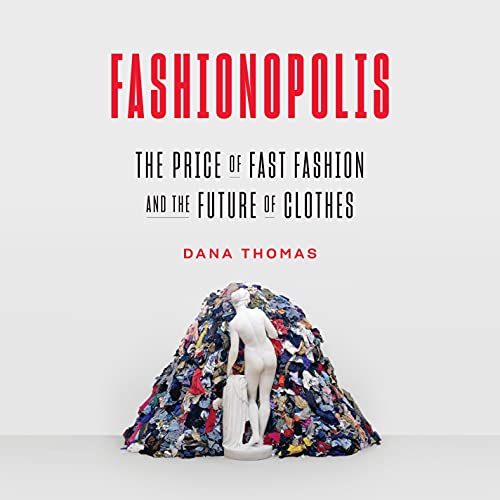
“Dana Thomas’s “Fashionopolis: The Price of Fast Fashion and the Future of Clothes” is a riveting exploration of the fashion industry and its impact on both the environment and workers. Thomas, an award-winning journalist and author, takes readers on a journey through the history of fashion, from the early days of haute couture to the rise of fast fashion and its devastating consequences.
Thomas’s extensive understanding of the fashion business, as well as her ability to present compelling stories that illustrate the human cost of fast fashion, is one of the book’s highlights. She provides a detailed account of the exploitation and abuse of garment workers, the environmental damage caused by the industry, and the toll that the pursuit of fast and cheap fashion takes on both consumers and the planet.
Throughout the book, Thomas emphasizes the need for a more sustainable and equitable fashion industry that values workers and the environment as much as profit. She argues that this is not only necessary for the well-being of the planet and its people, but also for the long-term success of the fashion industry itself.
Overall, “Fashionopolis” is a powerful and important book that offers a searing critique of the fashion industry and inspires readers to take action for a more just and sustainable future.
Recycling for Dummies
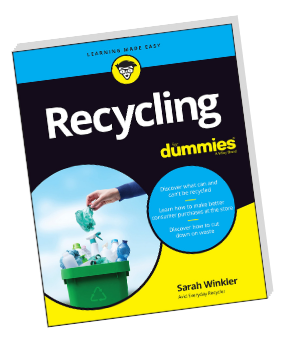
You might also like to check out my new book, called Recycling for Dummies.
You know that recycling will help reduce your impact on the planet, but how do you make sense of all the rules? Recycling for Dummies is packed with practical info to help you figure out what you can and can’t recycle and discover the reasons why. You’ll explore the many recycling services available and get an insight into how recycling works. Plus, this book goes one step further and teaches you how to reduce waste, make better decisions at the store, and buy recycled products so you can make a real difference.
The book was a passion project for me. I want everyone to feel like they can make a difference through recycling. I hope this book inspires you to improve your recycling habits and helps you understand the bigger picture and how recycling is just one part of the solution to our waste problems.
You can find out more here.








